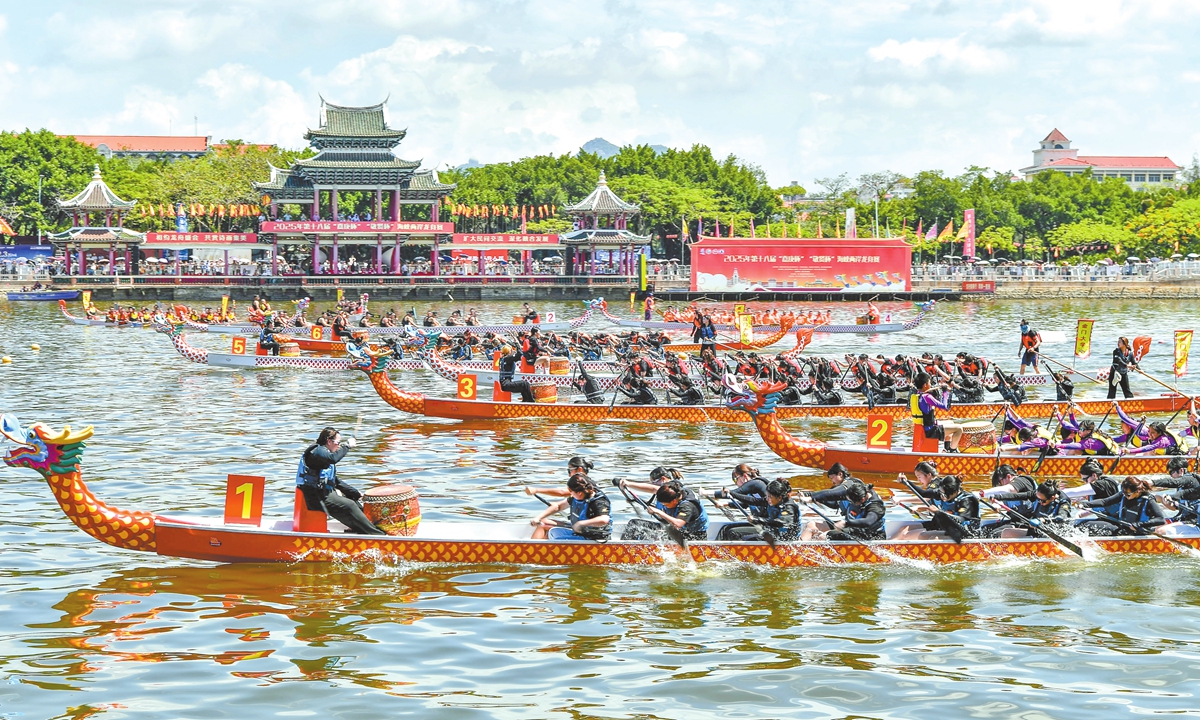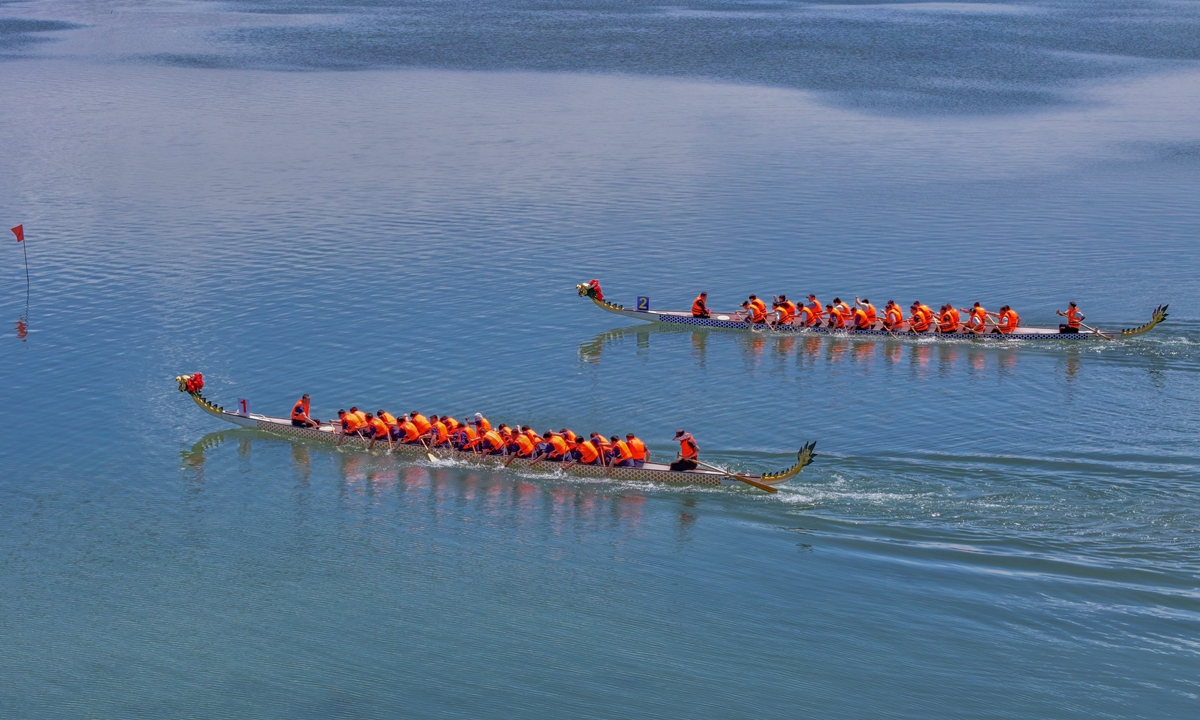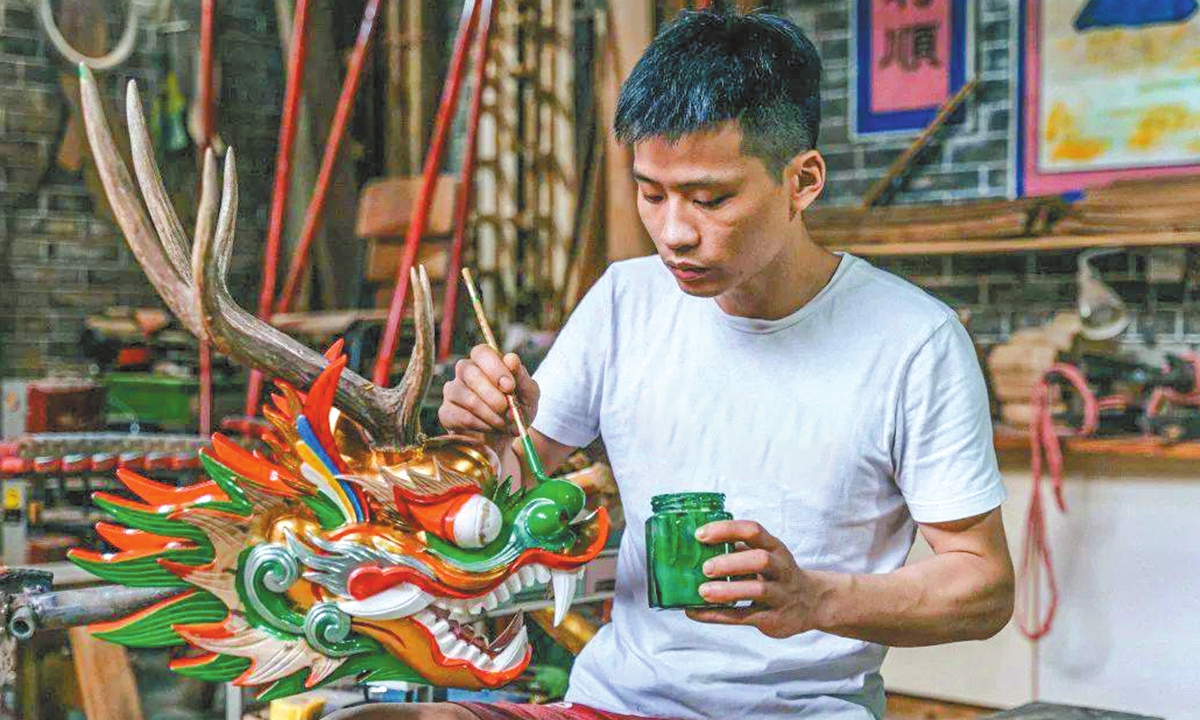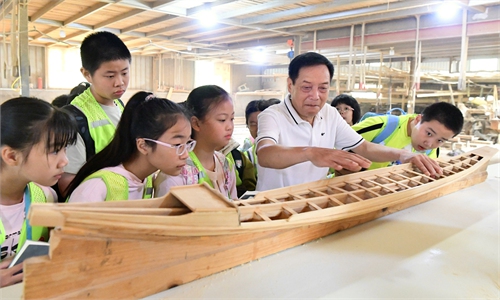ARTS / CULTURE & LEISURE
How dragon boat culture stays alive and thrilling
Art of paddle
Editor's Note:
A vivid thread of tradition continues to weave through China's modern cultural landscape, manifesting in deeply rooted yet ever-evolving rituals. Among them, the dragon boat race offers audiences a stunning fusion of collective spirit, physical daring and artistic heritage.
As part of the Global Times' "Neo-Chinese aesthetics" series, this story explores how Diejiao's iconic "corner-drifting" dragon boats and handcrafted dragon heads showcase not only kinetic beauty but also the enduring soul of a living tradition. From roaring paddles to the quiet patience of artisans, it is a story of bold strokes on water and time-honored carvings of identity.

Riding on the rhythmic drum beat, a 25-meter-long, six-meter-wide dragon boat hit the narrow and twisting waterways at high speed, with 32 paddlers and six steers as well as the drummer on board.
That is the typical scene of the online sensation "corner-drifting" dragon boat race in Diejiao, South China's Guangdong Province, with the narrow canals lined with spectators on both sides.
Their paddlers, dressed in matching indigo shirts, dip their oars in sync to create a rhythmic splash that merges with the pounding drums. The boats hug the sharp bends of the canals, their hulls tilting at dramatic angles that attract the audience to cheer and hail in the wild.
The scene in Diejiao is only one of the popular scenes about the dragon boat race toward the Dragon Boat Festival. As the fifth day of the fifth lunar month approaches, the waterways across the country transform into stages for a spectacle that blends power, precision and poetic beauty.
On this Saturday, thousands of dragon boats are expected to cut through the water, with their prows adorned with ornate dragon heads, paddlers moving in unison like a single, mythical beast awakening from slumber.
He Yi, secretary-general of the Chinese Dragon Boat Association, told the Global Times that over 700 official races are organized across the country during the Dragon Boat Festival period, with grassroots events organized by locals exceeding 1,000.

From small-town competitions where local families crew the boats to professional races like the China Dragon Boat Race, which this year's competition will be held in Enyang, Southwest China's Sichuan Province, the scale is awe-inspiring.
The Diejiao dragon boat activities, steeped in centuries of history, offer audiences a captivating blend of tradition, sport and community spirit.
According to Diejiao dragon boat cultural expert He Zhaobin, the origin of hosting dragon boat races in the region could be traced back to the Ming Dynasty (1368-1644), when people from central China brought the commemoration in honor of poet Qu Yuan.
The dragon boats have evolved over time, with more lightweight boats introduced in 2007, making it possible for the dragon boat races in Diejiao to deliver the drifting phenomenon, He said.
"Nowhere else in the country do dragon boats race at high speeds through such sharp bends," He said.
The folk atmosphere during the Dragon Boat Festival in Diejiao is unparalleled.
The spirit of "winning honor for the village" is deeply ingrained thus making the competition even more intense.
"There's even a competitive spirit of 'Better to smash the boat than row slowly,'" He said. Before the race, teams polish the boat hull and apply lard to reduce resistance, taking risks around corners to gain a 0.1-second advantage, demonstrating extreme perseverance.
The dragon head design in Diejiao also has its own story. Unlike the "exquisite and fierce" designs in Guangzhou, Diejiao's dragon heads are simple and rugged.
"The dragon head and neck are connected by a movable buckle, which can absorb shock and bounce back when hitting the shore to prevent possible damages. Even if the dragon head falls into the water during the race, it can be repaired and reused the next day," He said.
In recent years, more efforts have been made to ensure the inheritance of this unique culture. Since 2017, local authorities have started to introduce the "dragon boat culture into schools," which makes local young people more involved in the sport.
"Primary and secondary schools have introduced dragon boat-themed school-based courses to showcase traditional techniques," He said, noting a local U16 will participate in the national race in Enyang.
With the help of social media, the influence of Diejiao dragon boats has grown, attracting more and more young people to participate.
For the paddlers, they are all non-professional players, according to He. The local villagers generally started their preparation for the race in the second month of the lunar calendar.
The invitational tournament mechanism further enriches cultural exchange.
"After the four major competition areas' races each year, an 'Open Tournament' is added, inviting teams from Guangzhou, Foshan, Hong Kong, Macao in the Greater Bay Area. There are also plans to include teams from outside the province, but they need to use local dragon boats and helmsmen to ensure safety and fairness," said He.
This "corner-drifting" model in Diejiao is rare in China, attracting teams from other regions to experience it and establishing itself as a unique cultural phenomenon distinct from traditional dragon boat activities.

Passing the paddle
Behind the competitions, it is this spirit of boldness and determination in dragon boat racing that is embodied in the meticulously crafted dragon heads, each one a testament to cultural heritage and the dedication of skilled artisans.
By the riverbank in Guangzhou's Panyu district, craftsmen hand-carve traditional dragon boats, symbols of Lingnan's water culture, in century-old workshops.
Shangjiao village, with over 140 years of history and six generations of boat builders, remains the heart of Guangdong's dragon boat craftsmanship. Nearly 90 percent of the Pearl River Delta's traditional dragon boats come from here.
Normally, making a dragon boat involves key steps like building the hull, shaping the sides, adding decorations, binding ropes and finishing with oil and sanding. Even with modern tools, each boat takes about 20 days to complete.
"Now fewer young people are willing to learn, as training a skilled boat maker takes six to seven years, and that putting this centuries-old tradition at risk," Huang, a representative from the Panyu dragon boat workshop, told the Global Times.
Zhang Weichao, the 35-year-old young man and representative inheritor of the Huangpu District's intangible cultural heritage of dragon boat head and tail-making techniques, brought a glimmer of hope.
For Zhang, dragon boats have been part of his life for as long as he can remember. Growing up in a riverside village in Guangdong, dragon boat racing is not just an event marked on the calendar, it has been woven into the rhythm of daily life.
"In my hometown, dragon boat races meant more than even the Chinese New Year," Zhang told the Global Times. "As children, we were inseparable from the water, swimming and rowing small boats during summer. Dragon boats were everywhere."
Today, Zhang stands among a rare breed of young artisans who still hand-carve the ornate wooden dragon heads that adorn racing boats. His story embodies the struggle and dedication needed to keep this centuries-old craft alive amid modern distractions and rapid social change.
Zhang first brought national attention when he was invited to create a dragon boat head for the opening ceremony performance of the Beijing Winter Olympics in 2022.
Tasked with designing a piece that should honor traditional Lingnan culture and yet reflect the spirit of a winter sporting event, Zhang faced a unique challenge.
"It had to look fierce and dynamic, capturing the strength of the dragon and the unity of the Olympics," he explained. The result was a striking blend of age-old symbolism and contemporary artistry, marking a new chapter for this ancient tradition.
The process of making a dragon head is both painstaking and precise. Zhang begins by selecting quality wood, often fir or camphor for its grain and durability.
Using only traditional tools like chisels and saws, he carves each intricate detail: from the dragon's open jaws and flowing whiskers to its expressive eyes and flared nostrils. Once carved, the head is painted with colors chosen for its symbolic meaning, then coated with multiple layers of lacquer to protect it from sun and water damage. It can take more than a month of meticulous work to complete a single dragon head.
Yet Zhang's craftsmanship goes beyond replicating old forms. Every village that races dragon boats has its own stories, customs and aesthetic preferences. Some favor red-faced dragons symbolizing prosperity; others choose black dragons believed to repel evil spirits.
Before starting a new piece, Zhang spends time immersing himself in the local culture. "Each dragon head needs to reflect the soul of its village," he said. "So every design is deeply personal."
As orders increased, striking a balance between tradition and innovation was at the heart of Zhang's work.
While he insists on using hand tools and preserving traditional proportions, he also experiments with modern materials, like UV-sensitive paints or detachable horns to adapt to today's needs.
Now, Zhang's role extends beyond crafting dragon heads. His studio's apprentices collaborate with various artists, and advocate for intangible cultural heritage preservation.
"When the dragon head cuts through the water, it's more than a race," Zhang said. "It's a reminder of where we come from, and who we are."
A vivid thread of tradition continues to weave through China's modern cultural landscape, manifesting in deeply rooted yet ever-evolving rituals. Among them, the dragon boat race offers audiences a stunning fusion of collective spirit, physical daring and artistic heritage.
As part of the Global Times' "Neo-Chinese aesthetics" series, this story explores how Diejiao's iconic "corner-drifting" dragon boats and handcrafted dragon heads showcase not only kinetic beauty but also the enduring soul of a living tradition. From roaring paddles to the quiet patience of artisans, it is a story of bold strokes on water and time-honored carvings of identity.

People compete in a cross-Straits dragon boat competition in Xiamen, East China's Fujian Province, on May 17, 2025. Photo: VCG
Riding on the rhythmic drum beat, a 25-meter-long, six-meter-wide dragon boat hit the narrow and twisting waterways at high speed, with 32 paddlers and six steers as well as the drummer on board.
That is the typical scene of the online sensation "corner-drifting" dragon boat race in Diejiao, South China's Guangdong Province, with the narrow canals lined with spectators on both sides.
Their paddlers, dressed in matching indigo shirts, dip their oars in sync to create a rhythmic splash that merges with the pounding drums. The boats hug the sharp bends of the canals, their hulls tilting at dramatic angles that attract the audience to cheer and hail in the wild.
The scene in Diejiao is only one of the popular scenes about the dragon boat race toward the Dragon Boat Festival. As the fifth day of the fifth lunar month approaches, the waterways across the country transform into stages for a spectacle that blends power, precision and poetic beauty.
On this Saturday, thousands of dragon boats are expected to cut through the water, with their prows adorned with ornate dragon heads, paddlers moving in unison like a single, mythical beast awakening from slumber.
He Yi, secretary-general of the Chinese Dragon Boat Association, told the Global Times that over 700 official races are organized across the country during the Dragon Boat Festival period, with grassroots events organized by locals exceeding 1,000.

People compete in a dragon boat race in Zhangye, Northwest China's Gansu Province, on May 23, 2025. Photo: VCG
Craze in sportFrom small-town competitions where local families crew the boats to professional races like the China Dragon Boat Race, which this year's competition will be held in Enyang, Southwest China's Sichuan Province, the scale is awe-inspiring.
The Diejiao dragon boat activities, steeped in centuries of history, offer audiences a captivating blend of tradition, sport and community spirit.
According to Diejiao dragon boat cultural expert He Zhaobin, the origin of hosting dragon boat races in the region could be traced back to the Ming Dynasty (1368-1644), when people from central China brought the commemoration in honor of poet Qu Yuan.
The dragon boats have evolved over time, with more lightweight boats introduced in 2007, making it possible for the dragon boat races in Diejiao to deliver the drifting phenomenon, He said.
"Nowhere else in the country do dragon boats race at high speeds through such sharp bends," He said.
The folk atmosphere during the Dragon Boat Festival in Diejiao is unparalleled.
The spirit of "winning honor for the village" is deeply ingrained thus making the competition even more intense.
"There's even a competitive spirit of 'Better to smash the boat than row slowly,'" He said. Before the race, teams polish the boat hull and apply lard to reduce resistance, taking risks around corners to gain a 0.1-second advantage, demonstrating extreme perseverance.
The dragon head design in Diejiao also has its own story. Unlike the "exquisite and fierce" designs in Guangzhou, Diejiao's dragon heads are simple and rugged.
"The dragon head and neck are connected by a movable buckle, which can absorb shock and bounce back when hitting the shore to prevent possible damages. Even if the dragon head falls into the water during the race, it can be repaired and reused the next day," He said.
In recent years, more efforts have been made to ensure the inheritance of this unique culture. Since 2017, local authorities have started to introduce the "dragon boat culture into schools," which makes local young people more involved in the sport.
"Primary and secondary schools have introduced dragon boat-themed school-based courses to showcase traditional techniques," He said, noting a local U16 will participate in the national race in Enyang.
With the help of social media, the influence of Diejiao dragon boats has grown, attracting more and more young people to participate.
For the paddlers, they are all non-professional players, according to He. The local villagers generally started their preparation for the race in the second month of the lunar calendar.
The invitational tournament mechanism further enriches cultural exchange.
"After the four major competition areas' races each year, an 'Open Tournament' is added, inviting teams from Guangzhou, Foshan, Hong Kong, Macao in the Greater Bay Area. There are also plans to include teams from outside the province, but they need to use local dragon boats and helmsmen to ensure safety and fairness," said He.
This "corner-drifting" model in Diejiao is rare in China, attracting teams from other regions to experience it and establishing itself as a unique cultural phenomenon distinct from traditional dragon boat activities.

Zhang Weichao applies paint to a completed dragon head in his studio. Photo: Courtesy of Zhang Weichao
Passing the paddle
Behind the competitions, it is this spirit of boldness and determination in dragon boat racing that is embodied in the meticulously crafted dragon heads, each one a testament to cultural heritage and the dedication of skilled artisans.
By the riverbank in Guangzhou's Panyu district, craftsmen hand-carve traditional dragon boats, symbols of Lingnan's water culture, in century-old workshops.
Shangjiao village, with over 140 years of history and six generations of boat builders, remains the heart of Guangdong's dragon boat craftsmanship. Nearly 90 percent of the Pearl River Delta's traditional dragon boats come from here.
Normally, making a dragon boat involves key steps like building the hull, shaping the sides, adding decorations, binding ropes and finishing with oil and sanding. Even with modern tools, each boat takes about 20 days to complete.
"Now fewer young people are willing to learn, as training a skilled boat maker takes six to seven years, and that putting this centuries-old tradition at risk," Huang, a representative from the Panyu dragon boat workshop, told the Global Times.
Zhang Weichao, the 35-year-old young man and representative inheritor of the Huangpu District's intangible cultural heritage of dragon boat head and tail-making techniques, brought a glimmer of hope.
For Zhang, dragon boats have been part of his life for as long as he can remember. Growing up in a riverside village in Guangdong, dragon boat racing is not just an event marked on the calendar, it has been woven into the rhythm of daily life.
"In my hometown, dragon boat races meant more than even the Chinese New Year," Zhang told the Global Times. "As children, we were inseparable from the water, swimming and rowing small boats during summer. Dragon boats were everywhere."
Today, Zhang stands among a rare breed of young artisans who still hand-carve the ornate wooden dragon heads that adorn racing boats. His story embodies the struggle and dedication needed to keep this centuries-old craft alive amid modern distractions and rapid social change.
Zhang first brought national attention when he was invited to create a dragon boat head for the opening ceremony performance of the Beijing Winter Olympics in 2022.
Tasked with designing a piece that should honor traditional Lingnan culture and yet reflect the spirit of a winter sporting event, Zhang faced a unique challenge.
"It had to look fierce and dynamic, capturing the strength of the dragon and the unity of the Olympics," he explained. The result was a striking blend of age-old symbolism and contemporary artistry, marking a new chapter for this ancient tradition.
The process of making a dragon head is both painstaking and precise. Zhang begins by selecting quality wood, often fir or camphor for its grain and durability.
Using only traditional tools like chisels and saws, he carves each intricate detail: from the dragon's open jaws and flowing whiskers to its expressive eyes and flared nostrils. Once carved, the head is painted with colors chosen for its symbolic meaning, then coated with multiple layers of lacquer to protect it from sun and water damage. It can take more than a month of meticulous work to complete a single dragon head.
Yet Zhang's craftsmanship goes beyond replicating old forms. Every village that races dragon boats has its own stories, customs and aesthetic preferences. Some favor red-faced dragons symbolizing prosperity; others choose black dragons believed to repel evil spirits.
Before starting a new piece, Zhang spends time immersing himself in the local culture. "Each dragon head needs to reflect the soul of its village," he said. "So every design is deeply personal."
As orders increased, striking a balance between tradition and innovation was at the heart of Zhang's work.
While he insists on using hand tools and preserving traditional proportions, he also experiments with modern materials, like UV-sensitive paints or detachable horns to adapt to today's needs.
Now, Zhang's role extends beyond crafting dragon heads. His studio's apprentices collaborate with various artists, and advocate for intangible cultural heritage preservation.
"When the dragon head cuts through the water, it's more than a race," Zhang said. "It's a reminder of where we come from, and who we are."


